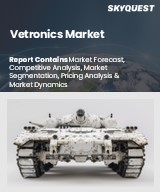
Report ID: SQMIG20A2324
SkyQuest Technology's Vetronics market size, share and forecast Report is based on the analysis of market data and Industry trends impacting the global Vetronics Market and the revenue of top companies operating in it. Market Size Data and Statistics are based on the comprehensive research by our Team of Analysts and Industry experts.
Global Vetronics Market size was valued at USD 4.96 Billion in 2023 and is poised to grow from USD 5.08 Billion in 2024 to USD 8.61 Billion by 2032, growing at a CAGR of 7.4% during the forecast period (2025-2032).
The vetronics sector is on the pathway to stable growth, supported by the increasing modernization of military vehicles and the need for situational awareness in the battlefield. Military service members across the globe are shifting gears toward digitized warfare and network-centric operations, and this priority brings a mission focus to modernifying and integrating advanced electronic systems into their vehicles, including command and control systems, sensor suites, and communication systems. The market is benefited as the shifts occur alongside an upward trend in defense budgets for key markets, including the U.S., China, and India.
Another key driver facilitating growth is the focus on soldier safety and effectiveness for military missions. Vetronics systems enable increased survivability by providing automated threat detection algorithms, real-time sharing of location and data, and measurements for precision targeting. The shrinking size and increasing adoption of unmanned ground vehicles (UGVs) and hybrid combat vehicles sets a new standard to drive innovation in vetronics architectures, particularly for more compact, modular, and energy-conservative forms of operation or integration.
However, there are key restraints for the market. The costs for development and system integration are tremendously high, and that can affect adoption, and installations are limited to certain defense forces without additional funding or budgets. Innovation will be limited in defense forces with legacy platforms when integration of multiple systems is needed during planning outside of mission locations. All of this is particularly challenging in terms of logistical deployment and preparedness during missions. Cybersecurity vulnerabilities remain a concern when digital connectivity increases across military platforms.
Integration of AI and Autonomous Technologies
The vetronics industry is seeing an explosive rise in the demand for AI-enabled systems and autonomous capabilities. These technology advances the situational awareness quality, decision making and combat effectiveness while facilitating the modernization programs for defense forces around the world.
REQUEST FOR SAMPLE
Global Vetronics Market size was valued at USD 4.96 Billion in 2023 and is poised to grow from USD 5.08 Billion in 2024 to USD 8.61 Billion by 2032, growing at a CAGR of 7.4% during the forecast period (2025-2032).
The vetronics market is a very competitive space where major defense contractors compete through different strategies to increase their share of the market. For example, Rheinmetall AG's acquisition of Loc Performance in 2024 for $950 million will increase the company's manufacturing depth in the United States aimed at securing contracts associated to future vehicle programs from the U.S. Army. This vehicle stuff can be significant, with an estimation of vehicle program contracts exceeding $60 billion. Moreover, BAE Systems has several existing contracts associated with upgrades of M2 Bradley fighting vehicles where vetronics upgrades will ultimately provide advanced smart power management as well as situational awareness systems. Lockheed Martin's use of advances in AI and sensors into vetronics systems will also potentially provide operational capabilities and situational awareness. 'BAE Systems (United Kingdom)', 'Curtiss-Wright Corporation (United States)', 'General Dynamics Corporation (United States)', 'Harris Corporation (United States)', 'Leonardo S.p.A (Italy)', 'Lockheed Martin Corporation (United States)', 'Raytheon Company (United States)', 'Rheinmetall AG (Germany)', 'Saab AB (Sweden)', 'Thales Group (France)', 'L3Harris Technologies Inc. (United States)', 'Elbit Systems Ltd. (Israel)', 'Kongsberg Gruppen ASA (Norway)', 'Oshkosh Corporation (United States)', 'Ultra (United Kingdom)', 'Northrop Grumman Corporation (United States)', 'Honeywell International Inc. (United States)', 'Moog Inc. (United States)', 'QinetiQ Group (United Kingdom)', 'Meggitt (United Kingdom)'
Advanced electronic systems provide greater situational awareness, improvements in communications, better navigation, and effective vehicle mobility which enhances operational efficiency and safety. One factor driving the market is the increased focus on network-centric warfare that requires the integration of the command, control, communications, computers, intelligence, surveillance, and reconnaissance (C4ISR) systems. Every day, there is greater adoption of vetronics solutions because the modern battlefield is being digitized, and armed forces are upgrading and replacing the legacy systems. Also, the influx of money into defense budgets along with continuing geopolitical uncertainty is further driving investments of advanced technologies in combat and support vehicles and promoting growth of the vetronics market worldwide.
What Makes Asia-Pacific a Leader in Vetronics?
Want to customize this report? This report can be personalized according to your needs. Our analysts and industry experts will work directly with you to understand your requirements and provide you with customized data in a short amount of time. We offer $1000 worth of FREE customization at the time of purchase.
Feedback From Our Clients

Report ID: SQMIG20A2324
sales@skyquestt.com
USA +1 351-333-4748